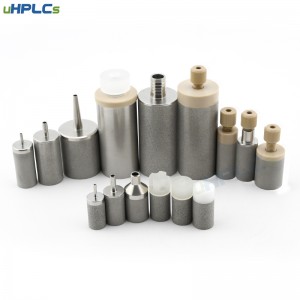High-performance liquid chromatography is an important branch of chromatography. This method has become an important separation and analysis technique in chemistry, medicine, industry, agronomy, commodity inspection, and legal inspection. Taking the pharmaceutical field as an example: the Chinese Pharmacopoeia contains a comparison table of high-performance liquid chromatography items and quantities:
|
Method |
Project |
Amount |
|||
|
1985 Edition |
1990 Edition |
1995 Edition |
2000 Edition |
||
|
HPLC method |
Identify |
- |
9 |
34 |
150 |
|
Examine |
- |
12 |
40 |
160 |
|
|
Assay |
7 |
60 |
117 |
387 |
|
Since HPLC is increasingly widely used in the whole industry, every laboratory analyst should be proficient in and apply HPLC and be able to easily analyze some common faults to solve the problem and improve work efficiency when the fault is running. For this reason, uHPLCs has sorted out about 30 common HPLC failures and countermeasure analysis plans, don’t miss them.
01 Reasons for drift or rapid change in retention time?
Regarding the drift problem.
① Poor temperature control, the solution is to use a thermostat device to keep the column temperature constant.
② The mobile phase changes. The solution is to prevent the mobile phase from evaporating, reacting, etc.
③ The HPLC column is not well equilibrated, and the column needs to be equilibrated for a longer period.
Regarding the immediate change problem.
① The flow rate changes. The solution is to reset the flow rate to keep it stable.
② There are air bubbles in the pump. Such operations can drive out the air bubbles as exhausting.
③ The mobile phase is not suitable. The solution is to change the mobile phase or make the mobile phase mix properly in the control chamber.
02 Reasons for the appearance of trailing or double peaks?
① Clogging of the hplc frit or column failure, the solution is to backwash the column, replace the frit or replace the column.
② Presence of interfering peaks, the solution is to use a longer column; change the mobile phase or replace the column with one with good selectivity.
③ Possible column overload, reduce the injection volume.
03 The main reasons and solutions for insufficient sensitivity of HPLC
① Insufficient sample volume, the solution is to increase the sample volume.
② The sample is not flowing out from the column. (ii) The mobile phase or column can be changed according to the chemical properties of the sample.
③ The sample and detector are not matched. Adjust the wavelength or change the detector according to the chemical properties of the sample.
④ The detector attenuation is too much. Adjust the attenuation.
⑤ The detector time constant is too large. The solution is to reduce the time parameter.
⑥ Detector window contamination. The solution is to clean the pool window.
⑦ There are air bubbles in the detection pool. The solution is to exhaust.
⑧ Improper voltage range of the recorder. Adjust the voltage range can be.
⑨ The flow rate of the mobile phase is not appropriate. Adjust the flow rate can be.
⑩ The detector and the recorder are out of the calibration curve. The solution is to check the recorder and detector and rework the calibration curve.
04 What is the reason for the unstable column pressure when doing HPLC analysis? How can I solve it?
① There is air inside the pump. The solution is to remove the air inside the pump and degas the solvent.
② The proportional valve is not working. Replace the proportional valve.
③ Damaged pump gasket. Just replace the gasket.
④ Air bubbles in the solvent, the solution is to degas the solvent, change the degassing method if necessary.
⑤ System leak detection, find the leak point, sealing can be.
⑥ Gradient elution, when the pressure fluctuation is normal.
05 Why can’t the retention time be reproduced after replacing another brand of ODS column?
This is because the analyte may have the ability to form hydrogen bonds. Although the manufacturing technology of packing materials has improved tremendously in the past few years, the concentration of silanol groups on the surface of ODS packing materials varies from manufacturer to manufacturer. It is these silanol groups that may interact with the sample. As a result, the relative retention times of the components of the same analyte may vary on different grades of ODS columns. Adding a small amount of a competitor, such as triethylamine (TEA), to the mobile phase will saturate the bonding ability of the silanol groups, thus ensuring good reproducibility of the relative retention times on the different column grades. If the separation situation can be, the system is stable and meets the system suitability requirements, and there is no need for the reproducibility of retention time.
06 Why is the column pressure too high during the HPLC column acceptance test?
High column pressure is the most common problem encountered by HPLC column users. There are many reasons for this, and often it is not the column itself. You can follow the steps below to check the cause of the problem.
① Remove the HPLC guard column and see if the column pressure is still high. Otherwise, it is a problem with the guard column. If the column pressure is still high, check again.
② Remove the column from the instrument and see if the pressure drops. Otherwise, the HPLC tubing is blocked and needs to be cleaned. If the pressure drops, check again.
③ Connect the inlet and outlet of the column to the instrument in reverse and flush the column with 10 times the column volume of the mobile phase (do not connect the detector at this time to prevent solid particles from entering the mobile cell). Check again if the column pressure does not drop; use only for used columns.
④ Replace the column frit in HPLC. If the column pressure drops, your solvent or sample contains particulate impurities, which clog the HPLC frit, causing the pressure to rise. If the column pressure is still high, please get in touch with the manufacturer. Generally, an in-line filter between the inlet and the guard column can avoid the problem of high column pressure.
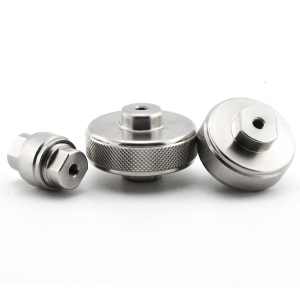
07 Will the mobile phase in the liquid chromatographic column drain?
Many people who do chromatographic separation tests have encountered a situation where the mobile phase was not replenished in time, and the pump drained the mobile phase from the solvent bottle. Thus, the HPLC system stopped working. Will this damage the column? Has the pump drained all the mobile phases from the column? Can the column still be used? If the pump drains the mobile phase from the solvent bottle, it will not damage the column. Even if the pump is full of Air, the pump will not exhaust the Air into the column. This is because the pump can only deliver liquid, not Air.
In contrast, another more likely scenario is forgetting to close the sealing caps on the ends of the column or having the caps too loose and drying out the column. Again, it is less likely that the entire column will dry out, and most likely, only a few millimeters at each end will dry out since it takes a considerable amount of time for the column to dry out by evaporating all the solvent. Even if the column does dry out, it is not necessarily irredeemable. Flushing the column with a completely degassed solvent with low surface tension (e.g., methanol degassed by helium) to remove the gas. The lower surface tension helps to wet the packing surface; the degassed solvent should be able to dissolve and remove any gas trapped in the packing. The column needs approximately one hour or more (at a flow rate of 1 mL/min) to be thoroughly wetted and restored to normal conditions.
08 Baseline drift causes and solutions
1. Causes of generation
① Column temperature fluctuations. (Even small temperature changes can cause baseline fluctuations. Usually, affect the differential detector, conductivity detector, lower sensitivity UV, or another photoelectric detector.)
② Mobile phase inhomogeneity. (Baseline drift caused by changes in mobile phase conditions is greater than the drift caused by temperature.)
③ Flow cell is contaminated or gas
④ Detector outlet blockage. (High pressure causes the flow cell window to break, producing a noisy baseline)
⑤ Improper mobile phase ratios or changes in flow rate
⑥ Slow column equilibrium, especially when the mobile phase changes
⑦ Mobile phase contamination, deterioration, or formulated by low-quality solvent
⑧ The sample has strongly retained substances (high K’ value) in the form of bun peaks
The sample is eluted, thus exhibiting a progressively higher baseline.
⑨ The use of circulating solvents is not advocated. The detector is not adjusted.
⑩ The detector is not set at the maximum absorption wavelength.
2. Solution
① Control the temperature of the column and mobile phase and use a heat exchanger before the detector
② Use HPLC-grade solvent, high-purity salt, and additives. Degas the mobile phase before use, and use in-line degas or helium degas during use.
③ Flush the flow cell with methanol or other strong polar solvents. If needed, use 1N nitric acid. (Do not use hydrochloric acid)
④ Remove the blockage or replace the tube. Refer to the detector manual to replace the flow cell window.
⑤ Change the ratio or flow rate. The mobile phase composition and flow rate can be checked periodically to avoid this problem.
⑥ Flush with a medium-strength solvent. When changing the mobile phase, flush the column with 10-20 times the volume of the new mobile phase before analysis. Use ion-pair reagents and buffer salts to balance the column more carefully.
⑦ Check the composition of the mobile phase. Use high-quality chemical reagents and HPLC-grade solvents
⑧ Change the analysis conditions. Use a protective column and flush the column with a strong solvent between injections or periodically during the analysis.
⑨ Reset the baseline. Use a new mobile phase.
⑩ Adjust the wavelength to the maximum absorption wavelength. Reselect the detection wavelength.
09 The causes of regular baseline noise generation?
1. Causes of generation
① Air in the mobile phase, detector, or pump (sharp peaks)
② Leakage of liquid.
③ Incomplete mixing of the mobile phase.
④ temperature effects (column temperature is too high, the detector is not heated)
⑤ In the same line with other electronic equipment (accidental noise)
⑥ Pump vibration
2. Solution
① Mobile phase degassing. Flush the system to remove Air from the detector or pump.
② Check whether the pipeline joints are loose, whether the pump is leaking, and whether there is salt precipitation and abnormal noise. If necessary, replace the pump seal.
③ Shake by hand to mix evenly or use a low-viscosity solvent
④ Reduce the difference or add a heat exchanger
⑤ Disconnect LC, detector, and recorder, check whether the interference comes from outside, and correct it. Use precision grade regulated power supply.
⑥ Add a pulse damper to the system.
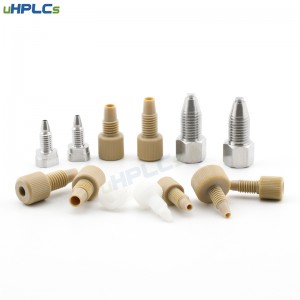
10 The causes of irregular baseline noise generation?
1. Causes
① Leakage of liquid.
② Mobile phase contamination, deterioration, or formulated by low-quality solvent
③The mobile phase is not soluble in each solvent
④ Problem with detector/recorder electronics
⑤ Bubbles in the system
⑥ Bubbles in the detector
⑦ Flow cell contamination (even a very small amount of contaminants can generate noise.)
⑧ Insufficient detector lamp energy
⑨ Column packing loss or blockage
⑩ Mobile phase mixing is not uniform, or the mixer does not work properly
2. Solution
① Check whether the joint is loose, whether the pump is leaking, and whether there is salt precipitation and abnormal noise. If necessary, replace the seal. Check whether the flow cell is leaking.
② Check the composition of the mobile phase.
③ Select a mutually soluble mobile phase
④ Disconnect the power supply of the detector and the recorder, and check and correct.
⑤ Clean the system with a strong polar Solution
⑥ Clean the detector and install a background pressure regulator behind the detector
⑦ Clean the flow cell with 1N nitric acid (not phosphoric acid)
⑧ Replace the lamp
⑨ Replace the column
⑩ Repair or replace the mixer. When the mobile phase does not go down the gradient, it is recommended not to use the pump mixing device
11 Retention time drift troubleshooting
There are two cases of retention time non-reproducibility: retention time drift and retention time fluctuation. The former means that the retention time changes only along a single direction, while the latter means that the retention time fluctuates without a fixed pattern. It is often helpful to distinguish between these two cases to find the cause of the problem. For example, drift in retention time is often caused by column aging, whereas column aging is unlikely to cause irregular fluctuations in retention time. Most of the retention time drifts are caused by different mechanisms of column aging, such as loss of stationary phase (e.g., by hydrolysis), column contamination (caused by sample or mobile phase), etc.
Several of the most common causes of retention time drift are as follows.
First. Column equilibration
If we observe retention time drift, we should consider whether the column has been fully equilibrated with the mobile phase. Usually, equilibration requires 10-20 column volumes of mobile phase, but if a small number of additives (e.g., ion-pair reagents) are added to the mobile phase, it can take quite a long time to equilibrate the column. Mobile phase contamination may also be a cause. Small amounts of contaminants dissolved in the mobile phase may slowly enrich the column and thus cause retention time drift. It should be noted that: water is a mobile phase component that can be easily contaminated.
Second. The stability of the stationary phase
The stability of stationary phases is limited, and even when used within the recommended pH range, stationary phases will slowly hydrolyze. For example, the silica matrix has the best hydrolytic stability at pH 4. The hydrolysis rate depends on the type of mobile phase and ligand. Bifunctional and trifunctional ligands are more stable than monofunctional ligands for bonded phases; long chain bonding is more stable than short chain bonding; alkyl bonding is more stable than cyano bonding. Frequent washing of the column also accelerates the hydrolysis of the column’s stationary phase. Other silica matrix bonded phases, such as amino bonding, can also be hydrolyzed in an aqueous environment.
Three. Column contamination
Another common cause of retention time drift is column contamination. HPLC columns are very effective adsorptive filters, which can filter and adsorb any material carried by the mobile phase. The source of contamination can be the mobile phase itself, the mobile phase container, connecting tubes, pumps, injectors and instrument gaskets, and samples. The source of contamination can be determined experimentally.
The presence of components in the sample strongly retained on the column may be a potential source of retention time drift. These sources are usually sample matrices. The easiest way to avoid column contamination is to prevent it from happening in the first place. Strong solvents are often used for a given chromatographic condition, but not all contaminants can be dissolved in the mobile phase. Using a protected column is a very effective method. Backflush columns are used only as a last resort.
Fourth. Mobile phase composition
Slow changes in the mobile phase composition are also a common cause of retention time drift. Such as the volatilization of volatile components in the mobile phase and the recycling of the mobile phase.
Fifth. Hydrophobic collapse
When a small pore size, reversed-phase packed column with a good end-base seal uses nearly 100% water as the mobile phase, a sudden loss of separation and a significant decrease in the analyte retention or no retention sometimes occurs, which is hydrophobic collapse. This phenomenon is caused by the mobile phase not wetting the stationary phase surface. The remedy is to wet the stationary phase with a mobile phase containing many organic components and equilibrate it with a mobile phase with a high water content. This phenomenon can also occur when the column is stored for a long time. Collapse can also be avoided by using reversed-phase columns with embedded polar groups (e.g., Waters SymmetryShield RP columns) or columns with non-end-group closures (e.g., Waters Resolve columns).
12 Why is there a shoulder peak or bifurcation?
① sample volume is too large – using the mobile phase to match the sample, the total sample volume is less than 15% of the first peak.
② The sample solvent is too strong – use a weaker sample solvent.
③ column collapse or formation of short-circuit channels replaces the column with a weaker corrosive condition.
④ Failure of the HPLC frit in the column – replace the HPLC frit, add an in-line filter, and filter the sample.
⑤ Injector damage – replace the injector rotor.
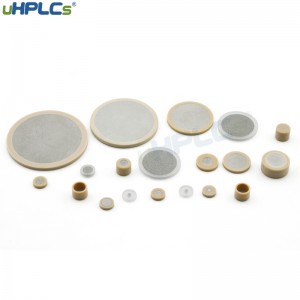
13 Why does ghost peaks?
① Residual peaks in the injection valve – clean the valve with a strong solvent after each use, improving the valve’s and the sample’s cleaning.
② Unknowns in the sample – process the sample.
③ Column not equilibrated – re-equilibrate the column and use the mobile phase as the sample solvent (especially for ion-pair chromatography).
④ Oxidation of trifluoroacetic acid (TFA) – freshly formulated daily, with antioxidants.
⑤ Water contamination (reversed phase) – check water quality by varying the equilibration time and using HPLC-grade water.
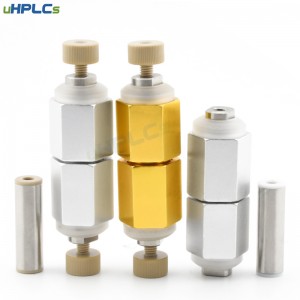
14 Why does the peak drag?
① Column overload – reduce the sample volume, and increase the column diameter to use a higher capacity stationary phase.
② Peak interference – clean the sample, and adjust the mobile phase.
③ Silicon hydroxyl effect – add triethylamine, passivate the column with alkali, increase the concentration of buffer or salt to reduce the pH of the mobile phase, and purify the sample.
④ Failure of HPLC frit in the column – replace the HPLC frit, add an in-line filter, and filter the sample.
⑤ Column collapse or formation of short-circuits channels – replace the column using less corrosive conditions.
⑥ Dead volume or excessive volume outside the column – minimize the connection points, make appropriate adjustments to all connection points, and use thin inner diameter connection tubes whenever possible.
⑦ Column efficiency declines – with lower corrosive conditions, replace the column with HPLC guard column.
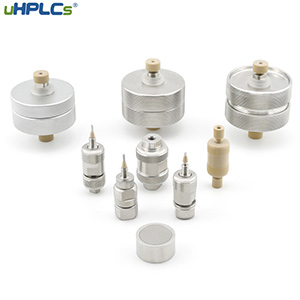
15 In addition to the flow rate, what other factors can cause pressure changes?
Change the composition of the mobile phase and temperature; change the column length, inner diameter, and packing size; column suddenly blocked pressure increase (under normal circumstances, other conditions are constant column pressure is gradually increasing).
16 What are strong solvents and weak solvents?
Changing the composition of the mobile phase or solvent strength can change the peak capacity factor and retention time. Under certain conditions, the solvent that decreases retention or shortens analysis time is strong. The solvent that increases the retention time or extends the analysis time is a weak solvent.
17 What makes a peak rearrange?
When analyzing multi-component samples, changing only the mobile phase’s strength (percentage composition) without changing its composition generally changes only the retention time of all components. It does not cause the peaks to rearrange.
Peak rearrangement may occur when the following conditions are changed: change of strong solvent in the mobile phase; change of pH value; change of column packing; change of column temperature; change of mobile phase composition (e.g., the addition of ion-pairing reagent triethylamine, etc.).
18 Besides online degassing, what are the other common laboratory degassing methods?
Heating reflux degassing is the best degassing effect but can not be maintained; the helium degassing this method is a good degassing effect and can remove more than ninety percent of the air, but helium is too expensive, so not much use; vacuum degassing effect is is second only to helium degassing, but the degassing process is easy to cause the sample solution volatilization loss; ultrasonic degassing, can only remove about thirty percent of the air, but the most commonly used in the laboratory. We still use online degassing, which is convenient and effective.
19 What are the most basic indicators to evaluate a chromatographic column?
The basic criteria for evaluating a column are the number of plates, peak asymmetry factor, column pressure drop, range of application and concentration of bonded phase, and peak capacity.
20 Why does the peak broadening occur?
① The sample volume is too large – the total sample volume is less than 15% of the first peak when the sample is matched with the mobile phase.
② Peak expansion in the injection valve – discharging air bubbles before and after the injection to reduce diffusion.
③ Data system sampling rate is too slow – set the rate should be greater than 10 points per peak.
④ Detector time constant is too large – set the time constant to 10% of the half-width of the first peak of interest.
⑤ Mobile phase viscosity is too high – to increase the column temperature, the use of low-viscosity mobile phase.
⑥ Detection cell volume is too large – use a small volume cell, and remove the heat exchanger.
⑦ Retention time is too long – isocratic elution to increase the content of strong solvent, also available gradient elution.
⑧ Excessive volume outside the column – reduce the diameter and length of the connecting tube to a minimum.
⑨ Sample overload – into a small concentration of a small sample volume.
21 Chromatographic double peaks generated by the possibility and judgment, and processing
In HPLC analysis, the peak shape should be symmetrical and sharp under the condition that the column is normal, the sample sensitivity is sufficient, the analysis method is appropriate, and the peak is in a short peak emergence time (excluding the gradient). However, the degree of understanding of the sample is not enough, the method is not appropriate, the sample processing methods and injection method are not reasonable, there will be a variety of unexpected problems, and the chromatographic peak is difficult to make a reasonable interpretation, especially for novices. Chromatographic double peaks refer to a substance, but in the chromatogram appear, double peaks indicate the presence of two kinds of substances. There are four reasons for this situation.
1. Liquid chromatographic column
Suppose you analyze a sample and find that each peak is double (the faster the peak, the less likely it is to be double), especially when using a single pure substance. In that case, you can be sure that there is something wrong with the column – the column head is damaged, or the stationary phase of the column head is dirty or lost. If the sample volume is small, the original column is normal, the shape of the peak is mostly a large peak with a small peak, not necessarily trailing, which should generally be a blocked column, the column will be reversed and connected to the mobile phase rinse or acid wash or other solvents, the residues blocked in the column to flush out. Then they reversed, in general, on the line, of course, not backflush. Positive flush sometimes will be normal. Suppose the peak trailing, double peak strength is not much different. In that case, the fixed phase of the column head becomes dirty, or loss is more likely, which can be unscrewed into that head, the microporous filter sonication, the column head scraped off part of the packing, refill the new packing tightened, but this kind of work, need a certain technology. At the same time, I do not always do that kind of thing or not a few times. The column should be very low column efficiency and scrap.
2. Solvent polarity and injection volume
Many HPLC analysts may not think about this, but the general HPLC books and literature will not mention this aspect of the content, which is a very important reason for the double peak. At present, HPLC analysis is mostly reversed-phase chromatography. The mobile phase is mostly methanol, acetonitrile, water, and various additives to improve the separation performance. The sample is generally dissolved with a solvent compatible with the mobile phase. The best dissolution method is to dissolve with the mobile phase, but many cases are inconsistent. The analytical system is dominated by water when using solvents with high polarity strength, such as pure methanol, pure acetonitrile, and pure ethanol. The sample injection volume is large, such as the quantitative tube is 20ul. This condition is completely certain that a single pure substance out of the double peak, the second peak is smaller than the first peak (each time is not quite the same), and trailing, the retention time will be advanced (relative to the small amount of injection), the injection volume will be reduced by more than half, the peak shape will become normal. This is caused by the difference in polarity between the solvent of the sample and the mobile phase, and the mobile phase is too late to dilute it to reach equilibrium. Another reason is that the injection volume is not necessarily large. Still, the absolute volume is large, and the double peaks on the chromatogram are close together, flush with each other, without trailing (if the peaks come out quickly, it may also be a column problem). The sample will be diluted and then into the sample can, which is due to the injection volume being too large, the column overload caused by.
3. The characteristics of the sample
In some samples, due to the characteristics of their chemical structure, there is the phenomenon of reciprocal isomerism. This reciprocal isomer cannot be separated but exists in a dynamic equilibrium. In the chromatographic analysis, under a specific condition, a substance will appear double peaks, double peaks close to each other, necessary flush high, no trailing, a slight change in conditions, especially pH, double peak phenomenon will disappear, such as erythromycin. Some samples can not be seen on the chromatogram of UV double peaks, but under LC-MS, with a mass spectrometry detector, the total ion flow of its mass spectrum on the graph is more obvious. For example, I have analyzed the pesticide acetamiprid (imidacloprid).

4. Parameters
The parameters of the record are generally built-in, with no need to modify, but the parameters of GC and HPLC are not the same. For example, the general recording interval on the C-R3A data logger GC is 2ms, and HPLC is 5ms. If the recording interval is shortened, a peak will become two or more.
22 Why do inverted peaks sometimes appear during the experiment?
The mobile phase used has absorption at the detection wavelength. Still, when the solution is fed into the mobile phase with no absorption at this wavelength or lower absorption than the mobile phase, cavities will appear in the mobile phase, and inverted peaks will appear after passing through the column.
23 Why is there a “fat” peak and a flat-head peak? How to avoid it?
Using a larger sample volume than the mobile phase’s strength will usually compromise the quality of the chromatogram and result in “fat” and flat peaks. The following rules should be followed to choose the solvent to dissolve the sample: A. It is best to dissolve the sample with the mobile phase. B. The main disadvantage of using a large volume of weak solvent to dissolve the sample, such as water, to dissolve the sample in reversed-phase chromatography is that a large negative peak appears at the beginning of the chromatogram after each injection, and sometimes the sample peak is also affected. C. Strong solvent to dissolve the sample when needed.
24 The occurrence and treatment of the front extension peak?
Some samples can be separated at room temperature, and the phenomenon of pre-delayed peaks disappears when the temperature increases. Another reason for pre-delayed peaks in ion-pair chromatography is using a non-mobile phase as the sample solvent. Therefore, only the mobile phase is required to dissolve the sample in ion-pair chromatography, and the injection volume should not be too large. Otherwise, it will lead to pre-delayed peaks or other problems. In RP-HPLC, the intensity of the sample solution is greater than that of the mobile phase causing pre-delayed peaks. Increasing the mobile phase’s strength, reducing the sample solution’s strength, and increasing the ionic strength in ion-pair chromatography can overcome the effect of pre-delayed peaks. In addition, using the mobile phase to dissolve the sample is the simplest and most practical way to solve the problem.
25 How can I easily determine if a proportional valve is leaking internally?
Set the pump to use a separate pathway (A), open the Purge valve, flow rate 5ml/min, lift the solvent filter head in other solvent bottles until it leaves the liquid surface, and observe whether the solvent in these pathways (B, C, D) flows with the flow. None of them should flow when normal.
26 The reason for the broadening of the peak?
Degradation of the column itself in the course of use, gradually reducing the column efficiency. b outside the column peak broadening effect. A good dedicated column used in another liquid chromatography system causes a decrease in the number of plates, indicating that the new system has a large off-column peak broadening effect. c chemical effect, mostly due to the interaction between the mobile phase and stationary phase, changing the mobile phase can improve the broad peaks.
27 What are the common causes of slow column equilibrium?
The common reasons for slow column equilibrium are strong component adsorption to the column in the old or new mobile phase or small or even zero concentration in the new mobile phase. Consider using a dedicated column for special methods, fold the column down when not in use, fill it with the appropriate solvent or mobile phase, seal it for safekeeping, and do not perform any other analysis.
28 What are the requirements for the internal standard?
A. The internal standard’s structure or physicochemical properties should be similar to those of the analyte.
B. The retention value of the internal standard should be slightly greater or less than the retention of the analyte and should not be too different.
C. the peaks of the internal standard should have good separation (R > 1.5) from the peaks of all analytes so that the internal standard does not become an interfering substance.
D. no structurally similar internal standard, the use of similarly retained internal standards.
E. instrument response to the analyte and the internal standard is the same. The size of the peak area can not be very different.
29 What is the “infinite diameter effect” of HPLC?
In HPLC analysis, due to the use of a high-efficiency particulate stationary phase and high-pressure mobile phase, the sample is injected into the column by the plunger. Because of the high resistance of the column, the molecular diffusion of the sample molecules in the column is very small. Until it flows out from the column, it does not come into contact with the inner wall of the column, thus causing little expansion of the chromatographic peak shape, which can maintain high column efficiency.
30 How to evaluate a detector?
A Noise: usually, noise refers to high-frequency noise and irregular fluctuations of the baseline generated by the electrical components of the instrument, temperature fluctuations, linear pulses of voltage, and other non-solute effects.
B Baseline drift: Drift is a slow upward or downward movement of the baseline that can be observed over a longer period (0.5 to 1h). It can mask noise and small peaks. Drift is related to the whole liquid chromatography system and is not only caused by the detector.
C Sensitivity (minimum detection concentration or minimum detection amount): The detector must have sufficient sensitivity for a particular separation job. When comparing detectors, the performance indicator sensitivity is often used. Sensitivity means the concentration or mass of solute entering the detector per unit of time when the signal-to-noise (signal-to-noise ratio) equals 2.
D linear range: When performing quantitative analysis, the detector should have a wide linear range so that both major and trace components can be detected simultaneously in one analysis; E detector pool volume: It should be less than 1/10 of the elution volume of the earliest outflow dead-time chromatographic peak. Otherwise, it will produce severe out-of-column band expansion.
Post time: Feb-24-2023


